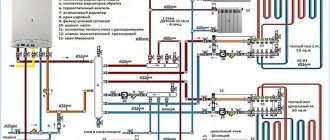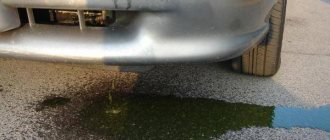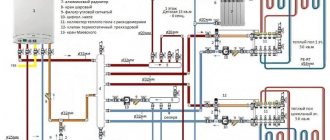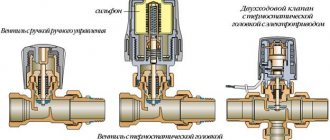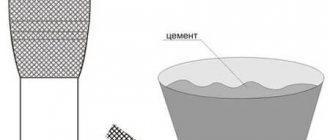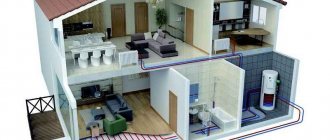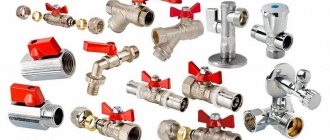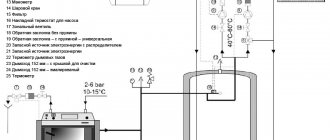For many of us, an autonomous heating system is truly a lifesaver, thanks to which we can make almost any home comfortable and cozy. A warm water floor is one of the most comfortable, efficient and convenient ways to heat residential premises. Despite the relative simplicity of the design and understandable operating scheme, even such heating systems can fail. Emergency situations in this case are rare, however, often quite unpleasant. The main problem that owners of private houses and apartments face in this situation is damage to the water circuit. Due to disturbances in technological processes and or as a result of mechanical damage to the pipeline, a leak appears.
If you experience malfunctions in the heating system, it means that your underfloor heating is damaged. If traces of coolant leakage are visible, the pressure in the system has dropped, it is necessary to urgently eliminate the situation. Otherwise, the situation threatens a new overhaul of the screed and reconstruction of the floor covering. We will consider in detail how to find damaged water floor pipes and what algorithm of actions in such a situation.
Changes in pressure gauge readings
Start by observing the pressure sensor mounted on the manifold, which directs water from your boiler to the various circuits of the hidden pipe. If you have information about the normal system pressure that the underfloor heating installer or technician who serviced the system should have provided, you can compare the readings and determine if the system pressure is dropping. Most systems maintain a pressure of 0.7 to 1.7 bar, but this depends on the design and spacing of the pipes. Low pressure is a clear indicator of a leak, so a system that reads 0 bar on the pressure gauge certainly needs immediate attention.
Repair of coolant leaks in heated floors
Here is a selection of materials:
Everything you need to know about heating and climate control Features of the selection and maintenance of boilers and burners. Comparison of fuels (gas, diesel, oil, coal, wood, electricity). Do-it-yourself ovens. Coolant, radiators, pipes, heated floors, circulation pumps. Chimney cleaning. Conditioning
After six years of operation, collets on a metal-plastic pipe began to leak. Apparently, the rubber gaskets dried out and wore out. And this pipe lays heated floors throughout my entire house. Moreover, some connections are made so that they are accessible for inspection and repair, and some are located inside the walls. If open ones began to leak, then leaks probably also appeared in hidden ones. The pressure in the heating system began to gradually decrease. I had to add water to the circuit every two days, although no water leaks were observed. With such an intensity of the leak, the water apparently had time to evaporate. But I'm afraid the leak may have gradually worsened.
I used car radiator leak sealant (radiator sealant). I took a bottle designed for 15 liters. I have 80 liters of coolant in my system. The next time water was added to the system, sealant was also pumped into the system. The leak did not stop immediately. As water was added, I added another bottle of sealant. I filled 4 bottles in total. Eventually the leak stopped completely.
Of course, there is no guarantee that this method will help. If the leak is due to a large hole, then the sealant will not help. But if the leak is not very intense, 5-7 liters leak out per day, then you can try.
Signs of damage
Because radiator heating pipes are embedded in a concrete slab to transfer heat from the water to the rest of the room, you can easily determine if your underfloor heating has a leak by carefully inspecting any damage to the flooring on that concrete slab. This is because concrete is a relatively porous material, which slows down the appearance of moisture on the surface so it can evaporate. Conduct a close inspection of your floor and pay attention to indirect signs of the consequences of a water leak, such as:
- damp or discolored carpeting;
- mold growth in places where the flooring meets the walls;
- linoleum or parquet tiles that deform and peel off;
- rust-like stains visible in the cracks between parquet tiles;
- Discoloration and mold on the grout joints of tiles that are not in a humid environment such as a bathroom or kitchen.
Water consumption
Since a properly installed underfloor heating system is a closed-loop system that runs the same water over and over again, you should not notice any signs of waste coming from the boiler. If your water meter is spinning slowly despite the fact that you have turned off all possible water points in the house, you are likely dealing with a leak in the heating system, which is forcing new water to fill the boiler to make up the difference. This subtle sign is often the first sign of a possible problem that causes a homeowner to question the condition of their underfloor heating system.
Heated floor BCG - leaking heated floor
- Home >
- Leak ›
- Heating
German liquid sealant from BaCoGa Technik.
BCG 30E sealant for “warm floors” is used in heating systems with water and gas boilers. It is suitable for “warm floor” pipes made of plastic and metal. In places where heating leaks, ageless elastic seals are formed. To obtain a long-lasting effect, BCG 30E liquid sealant must be left in the system, then the repair of the “warm floor” system will be of high quality. If the sealant for the "warm floor" system is used correctly, it will not cause damage to the pump and measuring instruments, and will eliminate leaks in the heating system. To help you find out how to fix a leak in the heating system, “warm floor”, and correctly carry out heating repairs in the house, read the instructions. Prices for German liquid sealant. If the “warm floor” is filled not with water, but with antifreeze, then you need to use BCG F.
How to seal a leak in a “warm floor” system?
- 1. In order for the leakage of the “warm floor” to be eliminated, the system filters must be removed or cut off with taps.
- 2. To ensure that water passes freely through the entire heating system where the pipe connection flows, open the main taps along the entire path of the sealant.
- 3. To eliminate the leak, the “warm floor” system is filled with coolant.
- 4. Eliminating heating leaks requires constant maintenance of temperature, pressure and coolant circulation.
- 5. Before sealing a leak in the “warm floor” system, check the serviceability of the pumps and remove air from the system.
- 6. Shake the container with BCG 30E thoroughly to stir the sediment at the bottom.
- 7. Before eliminating the leak in the “warm floor,” drain hot water in a volume equal to the amount of sealant poured into the “warm floor” pipe system.
- 8. Before sealing the pipe, sealant for heating pipes is added to the “warm floor” system using a pump.
- 9. Under these conditions, the operating time of the heating system is 7 hours so that the sealant is evenly mixed.
- 10. BCG 30E liquid pipe sealant seals and stops leaks in one day to a week. This depends on the state of the environment in which the leak occurred in the “warm floor” pipe and the size of the leak.
From the instructions, you learned how to fix a leak in a pipe of the “warm floor” system and can repair the heating pipes yourself.
Safety of working with underfloor heating sealant
When eliminating leaks in a heated floor system and working with sealant, do not forget about the safety rules. Pipe sealant is a chemical substance, so it is recommended to wear safety glasses and gloves. If the substance gets on your skin or in your mouth or eyes, rinse with water and call a doctor. Do not give to children and do not store near food or acid. You can dispose of the sealant for the “warm floor” system in the usual way. The developers are not responsible for the use of BCG 30E pipe sealant in violation of the instructions. The sealant consists of alkali silicates, cellulose fibers and special additives. Mix with water in a ratio of 1:100. If you dilute it in larger quantities, the effect will decrease. BCG 30E sealant for pipes and underfloor heating systems is resistant to temperature and pressure. Shelf life: 5 years. When storing, protect from frost.
Scale in the boiler
Do you suspect that your underfloor heating is being fed with fresh water due to a leak, but you can't pinpoint the problem with just a water meter? Try checking the boiler for signs of mineral deposits around the safety valves and other connectors on the tank. White or gray powder on or inside the boiler indicates that water with large amounts of minerals is constantly entering the boiler, which should not happen in a properly functioning closed system.
Warm floors do not heat well, uneven floor heat and other troubles
A heated floor can heat poorly for many easily eliminated reasons:
- If the boiler power is insufficient. Cleaning, preventative repairs and checking temperature sensors return it to the declared power. If there were initial miscalculations when designing or purchasing, then you can slightly redistribute the load: reduce floor heating where there is no urgent need for constant heating.
- The thermostat is not working, or the heated floor temperature sensor is located too close to the pipe, so to speak, transmitting not entirely correct measurements to the thermostat.
- Air entering the system. Calling a specialist is the most acceptable solution if you do not have confident skills or if an automatic air vent is not installed in the system. But, one way or another, there is only one task - to release the air, which will rise to the highest point (for a warm water floor this is a collector) when the system is suspended.
- The circulation pump does not work. Check the power supply to the pump; if it fails, there are two solutions and they are clear: buying a new one or repairing it.
- Problems with only one circuit. Sometimes it is enough to check its connection and settings in the connecting panel. The reason may be the distribution of coolant volume throughout the system. If it is the same for all circuits, and the problematic one is longer, then this explains the decrease in temperature in this circuit - the coolant has time to cool closer to the outlet. But we cannot exclude the presence of the problems described above for the entire Warm Water Floor system.
Despite the long list of potential problems, it should be understood that hydronic underfloor heating remains a very reliable heating system. And if you take a responsible approach to its installation, settings, operating mode, and preventative maintenance, then you won’t have to deal with any of them.
Our construction company reminds: only in combination with reliable insulation of the house, a warm water floor can serve as the main heating system, economical and comfortable.
Leak noise
Finally, you may get lucky and actually hear the leak if you keep the house completely quiet and take the time to listen to the floor. Large leaks can cause hissing and whistling sounds to be heard through the floor. Enhancing your natural hearing ability with a medical stethoscope may help a little, but you will need a complex and expensive device to electronically amplify the sound and filter out extraneous noise to get the best results at this stage. If you hear some strange sounds, but cannot determine what is their source (pipes of a warm water floor circuit or something else), the most correct option is to hire specialists who are equipped with thermal imaging equipment, ultrasonic sensors, geophones and other high quality equipment for detecting such leaks.
Steps to eliminate a leak with liquid sealant
The procedure for using liquid sealants to repair your home heating system can seem quite complicated. In some cases, clots of sealing fluid cause partial blockage and impede the movement of the coolant. Therefore, in order not to cause damage to the heating equipment due to your inexperience, it is better to invite a specialist. In any case, you need to study the instructions for using a specific type of sealant for radiators and strictly follow them.
Having decided to use a liquid sealant to fix a problem in the heating system, you need to make sure that:
- the reason for the pressure drop is precisely the leakage of coolant, and is not related to a malfunction of the expansion tank;
- the selected type of sealant for heating systems corresponds to the type of coolant in the system;
- The sealant is suitable for this heating boiler.
When using liquid sealant for pipes and radiators, it is important to maintain the correct concentration. On average, its values range from 1:50 to 1:100, but it is advisable to determine the concentration more accurately, since the effectiveness of eliminating leaks can be affected by factors such as:
- coolant leak rate (up to 30 liters per day or more);
- the total volume of water in a given heating system.
If the volume does not exceed 80 liters, 1 liter of sealant will be enough to pour into the heating system. But how can we more accurately calculate the volume of water in the system? You need to calculate how many meters of pipes and what diameter were laid in the house, and then enter this data into one of the online calculators. To the resulting volume of pipelines, you must also add the passport characteristics of the volumes of all radiators and the boiler.
You can drain all the water from the system into a certain container, the volume of which is precisely known, and then fill the system again.
Preparing the heating system
- Dismantle or cut off all filters with taps so that they do not become clogged with a viscous solution of sealant for heating systems;
- Unscrew the Mayevsky valve from one radiator (the first one in the direction of coolant flow) and connect a pump to it (the “Baby” type);
- Start the heating system and let it warm up for an hour to a temperature of 50–60°C at a pressure of at least 1 bar;
- Open all taps on pipelines and radiators to allow sealant to flow freely through them;
- Remove air from the entire system, including the radiators and circulation pump.
If the air is not completely vented, it will begin to react with the sealant and cause it to thicken in places other than where it is needed to eliminate the leak.
Preparing the sealant
Drain about 10 liters of hot water from the system into a large bucket, use most of it to prepare a sealant solution, and leave a few liters for subsequent flushing of the pump;
